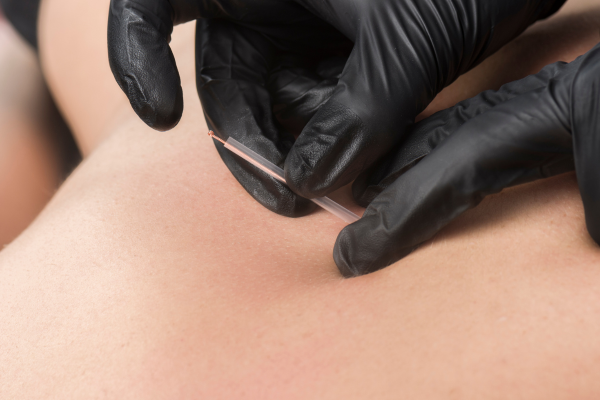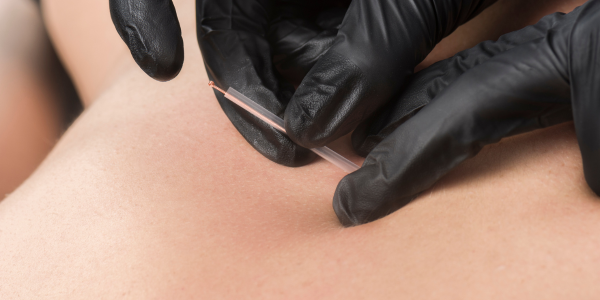How does dry needling work?
Chronic pain can significantly impact your daily life, limiting your mobility and overall well-being. Fortunately, physiotherapy offers various treatment options to manage pain and improve function. One such technique gaining popularity is dry needling. But how exactly does dry needling work?
This blog delves into the science behind dry needling, exploring its mechanism of action and potential benefits. We’ll also address some common questions about dry needling to help you decide if it’s the right approach for your pain management.

What is Dry Needling?
Dry needling is a form of physical therapy that utilizes thin filiform needles to target taut bands of muscle fibers known as trigger points. These trigger points are believed to contribute to pain, even in areas distant from the point itself.
While dry needling resembles acupuncture, there’s a key difference. Acupuncture focuses on balancing the body’s energy flow, while dry needling targets specific trigger points to address musculoskeletal dysfunction.
How Does Dry Needling Work?
The exact mechanism of dry needling’s pain-relieving effects is still being researched. However, several theories explain its potential benefits:
Mechanical Stimulation: Inserting the needle into a trigger point disrupts the tight muscle fibers, potentially reducing tension and improving blood flow to the area. This can promote healing and reduce pain sensitivity.
Neuromodulation: The needle may stimulate nerves within the muscle, sending signals to the spinal cord and brain that can alter pain perception. This can lead to a decrease in pain signals reaching the brain.
Local Twitch Response: Sometimes, inserting the needle elicits a brief involuntary muscle contraction (twitch) in the trigger point. This twitch response may help to release muscle tension and improve flexibility.
Increased Endorphin Release: Dry needling may stimulate the body’s production of endorphins, natural painkillers that can further reduce pain perception.
Benefits of Dry Needling:
Dry needling can be a valuable tool for managing various pain conditions, including:
Myofascial pain syndrome: This chronic pain condition is characterized by pain and tenderness in the muscles and fascia (connective tissue).
Neck pain: Dry needling can target trigger points in the neck muscles that contribute to headaches and neck stiffness.
Back pain: Dry needling can address trigger points in the lower back muscles that contribute to pain and limited mobility.
Shoulder pain: Trigger points in the shoulder muscles can cause pain, weakness, and difficulty with movement. Dry needling can help alleviate these symptoms.
Tennis elbow and golfer’s elbow: These conditions involve pain in the elbow due to overuse or strain. Dry needling can target trigger points in the forearm muscles that contribute to elbow pain.
Other conditions: Dry needling may also be beneficial for managing headaches, migraines, and pain related to sports injuries.
What to Expect During a Dry Needling Treatment:
A qualified physiotherapist will perform a thorough assessment to determine if dry needling is suitable for your condition. During the treatment, the physiotherapist will insert thin filiform needles into identified trigger points. You may feel a twitch or a dull ache when the needle is inserted. The needles are typically left in place for a few seconds to a few minutes.
The number of needles used and the duration of treatment will vary depending on your individual needs. You may experience some soreness or discomfort after the treatment, which usually resolves within a day or two.
Is Dry Needling Right for You?
Dry needling is generally safe and well-tolerated when performed by a qualified physiotherapist. However, it may not be suitable for everyone. Here are some things to consider:
Medical Conditions: If you have certain medical conditions, such as bleeding disorders or an implanted pacemaker, dry needling may not be recommended.
Pregnancy: While research is limited, dry needling is generally not recommended during pregnancy.
Medication Use: Certain medications, such as blood thinners, may increase the risk of bleeding during dry needling.
Conclusion:
Dry needling offers a promising approach to managing pain and improving muscle function. If you’re struggling with chronic pain, consulting a qualified physiotherapist can help you determine if dry needling is a suitable treatment option for you. Keep in Motion Physio offers dry needling services in the Epping and Craigieburn areas.
Frequently Asked Questions
Does Dry Needling Hurt?
Dry needling can cause some discomfort, but it’s generally not considered painful. The needles are very thin, and the feeling is often described as a twitch or a dull ache. Some areas may be more sensitive than others, but a skilled physiotherapist will minimize discomfort. You may also experience some soreness after treatment, which usually goes away within a day or two.
How Quickly Does Dry Needling Work?
Many people experience some improvement in their symptoms within 24-48 hours after dry needling. The full benefits may take a few sessions, depending on the severity of your condition. It’s important to be patient and consistent with your treatment plan.
How Many Dry Needling Sessions Will I Need?
The number of dry needling sessions you need will vary depending on your individual situation. Some people may only need one session, while others may need several sessions spread out over a few weeks. Your physiotherapist will develop a personalized treatment plan based on your needs.
Are There Any Side Effects of Dry Needling?
Dry needling is generally safe when performed by a qualified physiotherapist. However, some potential side effects include:
- Minor bruising
- Bleeding
- Muscle soreness
- Dizziness (rare)
These side effects are usually mild and temporary. If you experience any concerning side effects, be sure to tell your physiotherapist.
Is Dry Needling Safe for Everyone?
Dry needling may not be suitable for everyone. People with certain medical conditions, such as bleeding disorders or implanted pacemakers, may need to avoid it. Pregnant women should also consult with their doctor before undergoing dry needling.
What’s the Difference Between Dry Needling and Acupuncture?
While both techniques use thin needles, there are key differences. Dry needling specifically targets trigger points to address musculoskeletal dysfunction, while acupuncture focuses on balancing the body’s energy flow.
Can Dry Needling Help with My Specific Condition?
Dry needling can be effective for a variety of pain conditions, including myofascial pain syndrome, neck pain, back pain, and headaches. However, it’s always best to consult with a qualified physiotherapist to determine if dry needling is the right approach for your specific needs.
Where Can I Find a Qualified Physiotherapist for Dry Needling?
Look for a physiotherapist who has received proper training and certification in dry needling. Many physiotherapy clinics offer dry needling services. You can also search online directories of qualified physiotherapists in your area.
Also check out our blog post on Medium.
Keywords – Dry needling, Dry needling work, How does dry needling work.

